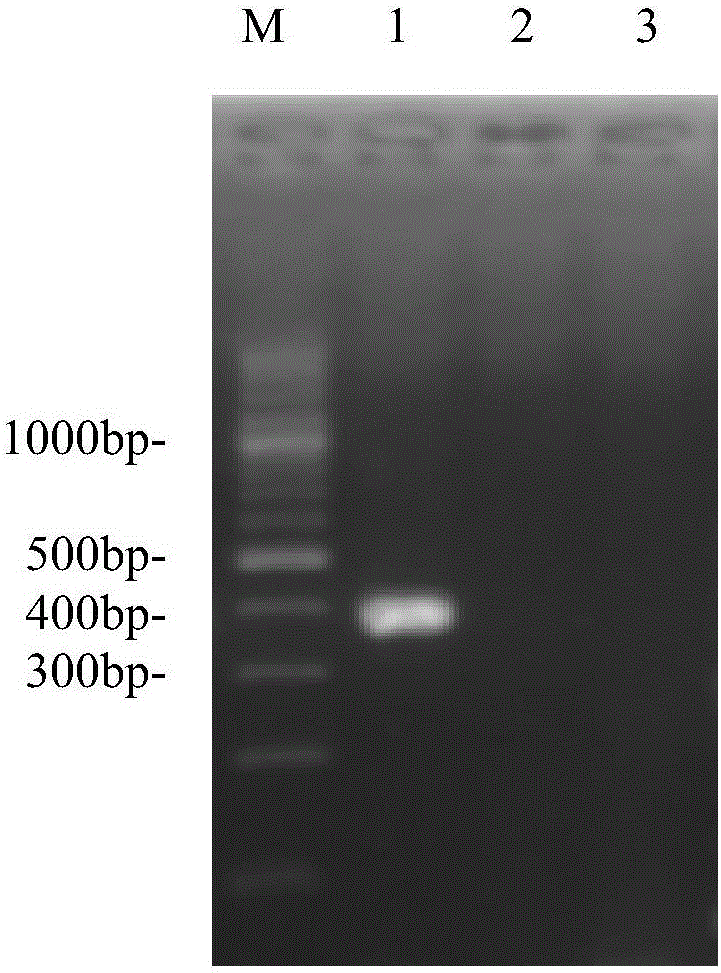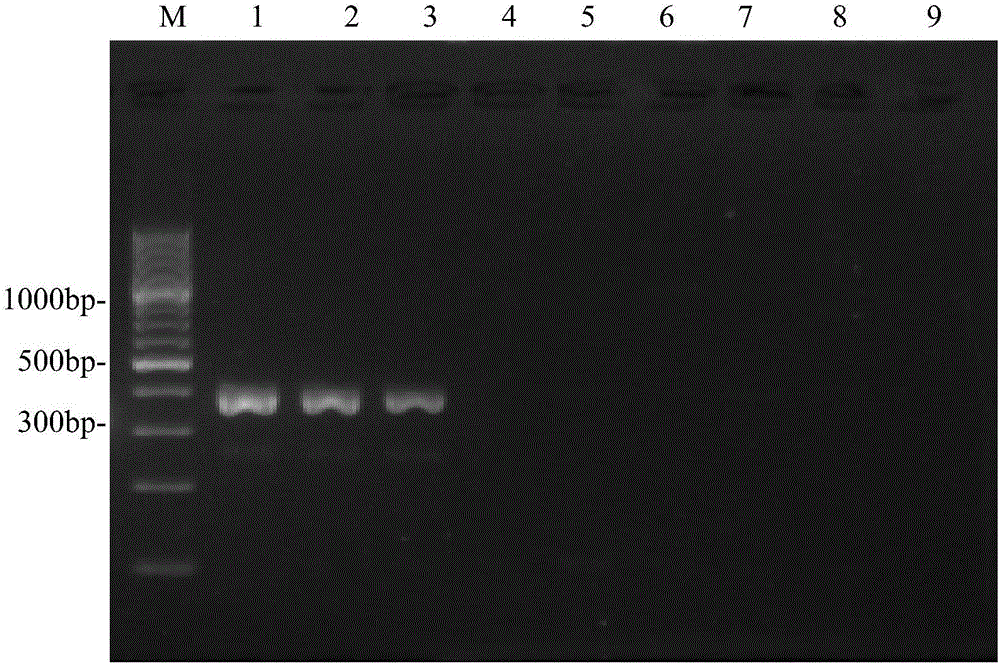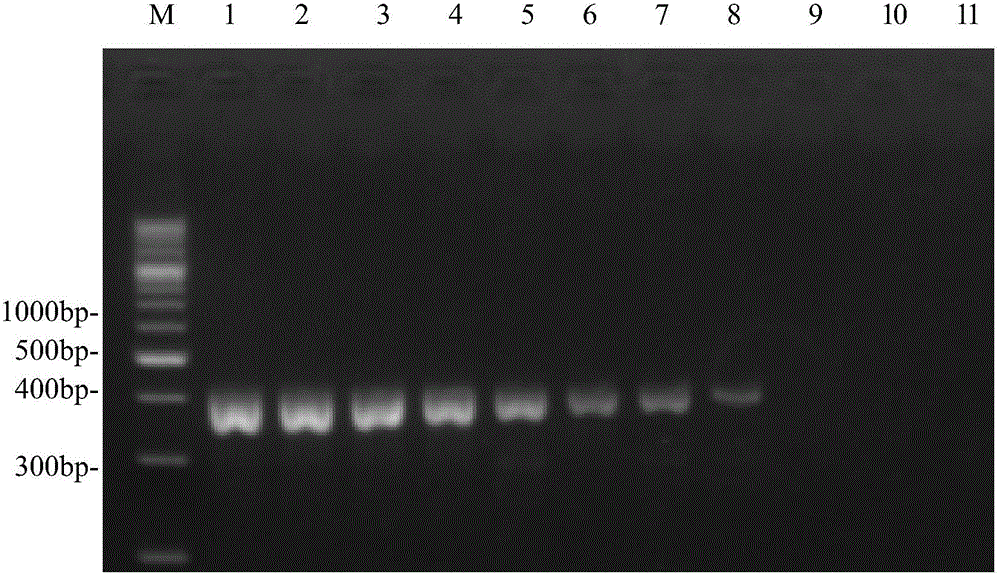Primer pair for preparing kit for detecting type-4 avian adenovirus and application thereof
A detection kit and technology for poultry adenovirus, applied in the biological field, can solve problems such as the increase in reported cases and the economic loss of the poultry industry, and achieve the effect of accurate results and high detection sensitivity
- Summary
- Abstract
- Description
- Claims
- Application Information
AI Technical Summary
Problems solved by technology
Method used
Image
Examples
Embodiment 1
[0043] Example 1 DNA Extraction
[0044] 1. Sample processing
[0045] Treatment of tissue samples: Take tissues that are easy to separate FAdV4, such as the liver and spleen of dead chickens, cut them into pieces with scissors, add sterilized PBS at a volume ratio of 1:3, and grind them thoroughly. The homogenized tissue suspension was repeatedly frozen and thawed at -20°C (or lower)-room temperature for 3 times, then centrifuged at 12,000g for 10min, and 200μL of the supernatant was taken into a new sterilized centrifuge tube.
[0046] Allantoic fluid treatment: collect the allantoic fluid from virus-infected chicken embryos and centrifuge at 12,000 g for 10 min, and take 200 μL of the supernatant into a new sterilized centrifuge tube. At the same time, the allantoic fluid of uninfected chicken embryos was collected as a negative sample; the allantoic fluid infected with FAdV4ZJ2015-1 was used as a positive control.
[0047] 2. DNA extraction
[0048] Take 200 μL of the a...
Embodiment 2
[0049] Embodiment 2 PCR reaction
[0050] 1. Primer design
[0051] According to the conserved sequence on the FAdV4 structural protein Hexon gene, the following primers were designed and synthesized:
[0052] FAdV-F is 5'-ATACCAACACGAGCACCTC-3';
[0053] FAdV-R is 5'-TTATCCCTGAACCCGATG-3';
[0054] It is expected to amplify a 403bp DNA fragment of avian adenovirus. The sequences of the primers are shown in SEQ ID NO.1 and SEQ ID NO.2.
[0055] 2. PCR reaction
[0056] Take 2.5 μL of extracted DNA, add 2 μL each of 10 uM primer FAdV-F and 10 uM primer FAdV-R, 2.5 mM dNTP 4 μL, 10×buffer 5 μL, template 2.5 μL, add water to 50 μL; : Pre-denaturation at 95°C for 5min, denaturation at 95°C for 30s, annealing at 55°C for 30s, extension at 72°C for 30s, 35 cycles, and extension at 72°C for 10min for PCR amplification.
[0057] The PCR products were subjected to 1.5% agarose gel electrophoresis, stained with DueRed, and observed under ultraviolet light. The result is as figur...
Embodiment 3
[0060] Example 3 Specificity verification of the kit
[0061] Take the extracted DNA and common poultry viruses from 3 positive disease samples from Shandong obtained by our laboratory, including other serotypes of adenovirus (type 1 and type 5), avian influenza virus, chicken Newcastle disease virus, chicken infectious bronchitis virus The DNA extracted from the allantoic fluid of infected chicken embryos was subjected to PCR under the same conditions.
[0062] The result is as figure 2 As shown, only the target DNA fragments of the expected size were amplified from the DNA extracted from the three disease materials, but no DNA bands were amplified from other selected poultry disease viruses, indicating that the established PCR method has high specificity .
PUM
 Login to View More
Login to View More Abstract
Description
Claims
Application Information
 Login to View More
Login to View More - R&D
- Intellectual Property
- Life Sciences
- Materials
- Tech Scout
- Unparalleled Data Quality
- Higher Quality Content
- 60% Fewer Hallucinations
Browse by: Latest US Patents, China's latest patents, Technical Efficacy Thesaurus, Application Domain, Technology Topic, Popular Technical Reports.
© 2025 PatSnap. All rights reserved.Legal|Privacy policy|Modern Slavery Act Transparency Statement|Sitemap|About US| Contact US: help@patsnap.com



